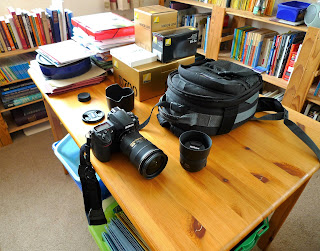So, I'd got the Leica X-U back home. It was time to unbox it carefully, and see exactly what I'd got.
The box was large. Impressively, it seemed pristine. I felt I should applaud the previous owner for putting it away carefully five years back. Easing out the tab on the front top edge of the box made the whole thing open outwards, like a flower at dawn. (I took photos, now and subsequently, with the little Leica D-Lux 4 and Prudence, my phone)
This revealed a black cardboard cabinet, beautifully made, with magnetic catches and a flip top, and - lower down - pull-out black plastic trays. It was like a miniature chest of drawers. I flipped the top over, to reveal an inner box that contained the X-U itself, in a plastic wrapper, resting in a bed of foam rubber, cut out to take it. The lid of this inner box also had a cut-out in the rubber foam, to fit precisely over the camera, making it immovable in storage and transit.
I now contemplated the camera from various angles. It looked completely at home in my lounge.
The lower 'drawers' of the box contained several accessories, including the neck strap mentioned in my last post, and this blue neoprene sleeve, open at each end but closable with toggles. It puzzled me. Was it a dust cover? One week on, I have discovered that it is meant to be 'a multi-purpose sleeve' for 'outdoor activities' and can be 'a camera bag, beanie or neck-warmer'. That's official.
Yes! If closed at one end, it can literally be popped onto the head and worn as a hat. Or if both ends are open, pulled further down to keep the neck cosy - or perhaps protect it from too much sun, such as you find in them thar mountains!
Lucky neck, I say. And of course, that blue will go with anything...
Look at that! Leica provided a real instruction manual for the X-U, in German (the first half) and English (the second half). Only needed, so far, to clear up a few points concerned with white balance, sequential photo file numbering, and reformatting the SD card, as almost everything about this camera is pretty clear and obvious. But very nice to have a physical manual, all the same. Sehr bequem!
This was the free alternative neck/cross-body strap I'd asked for, made by Op/Tech USA:
Ready for action. Take me to the headwaters of the Orinoco. Sofort!
This is how the X-U compares in size to the little Leica D-Lux 4:
It's decidedly bigger. I'd say it's twice the size. And it's roughly twice the weight too - although when carried about the weight difference is somewhat less. The D-Lux 4 needs a bag, but the X-U doesn't. Worn across my body in its bag, with a spare battery included, the D-Lux 4 weighs 440g. The Leica X-U, carried the same way with its strap attached, but no bag, comes in at 710g - only 270g more - although when I bring along a spare BP-DC8 battery - not always necessary - that adds another 37g.
I don't like heavy, bulky cameras. This one is fine. True, I'd ideally prefer something as light as the little D-Lux 4, but such a thing is not to be had if I'm insisting on better pictures.
I can't help thinking about the full-frame Nikon D700 (and the lenses I bought for it) that I owned from 2008 to 2011. Its body alone weighed 995g. With my favourite 24-70mm f/2.8 lens fitted, the body/lens combination weighed 2 kilograms - almost three times the weight of the Leica X-U - and that was really too much. But it looked the business.
It's interesting to compare the weight of the X-U with Fujifilm's Leica-inspired X100V, the current darling of street photographers. Here it is:
I could have bought a new X100V (plus essential accessories) for some £400 less than I paid for my pre-owned Leica X-U. It was a contender as the eventual replacement for my ageing D-Lux 4, but it wasn't by any means the only possibility.
Since its launch in early 2020 I have regarded the X100V as a handsome camera, but with rather too many external controls. Its prime selling point is its fancy viewfinder - which I would be unwilling to pay for. Its thin but articulating rear screen looks flimsy to me. Studying the many test photos I've seen on the Internet, the X100V delivers pictures that lean towards the rich greens that Fujifilm was always famous for, to the detriment of its reds, which look a little weak. Whereas Leica's reds are bold and strong and hit you in the eye. The X100V is undeniably attractive, its design 'classic' and fashionably retro, but although well-made it's not as robust as my X-U. That said, it is a bit smaller, and weighs correspondingly less, only 478g.
Am I kicking myself, for not going for the X100V? No. It wasn't my ideal next camera before I bought the X-U, and nothing has changed.
So that's the unboxing done. Now for the first shots. Next post.































